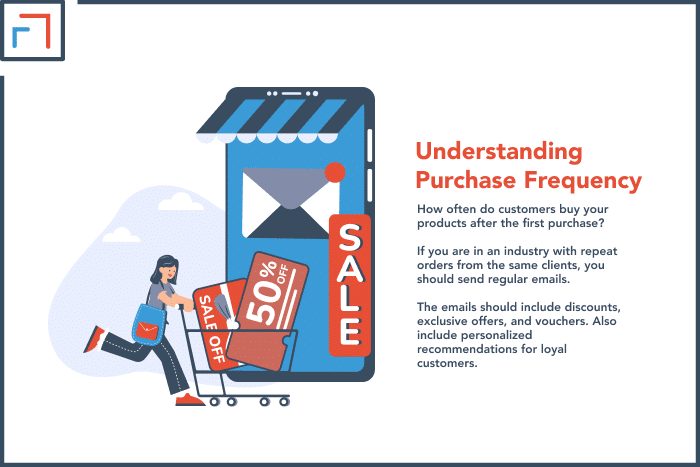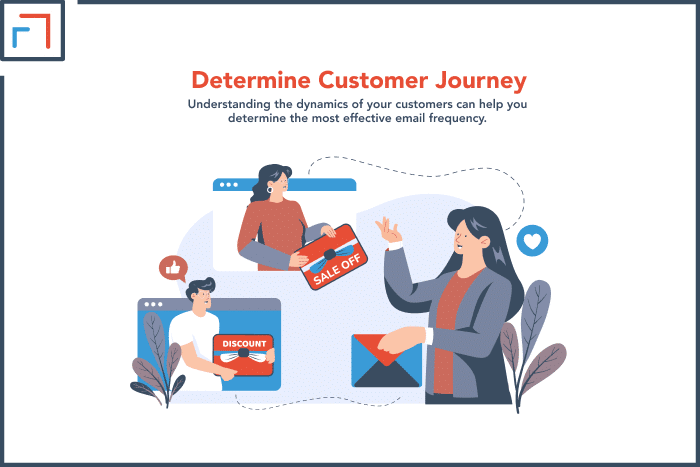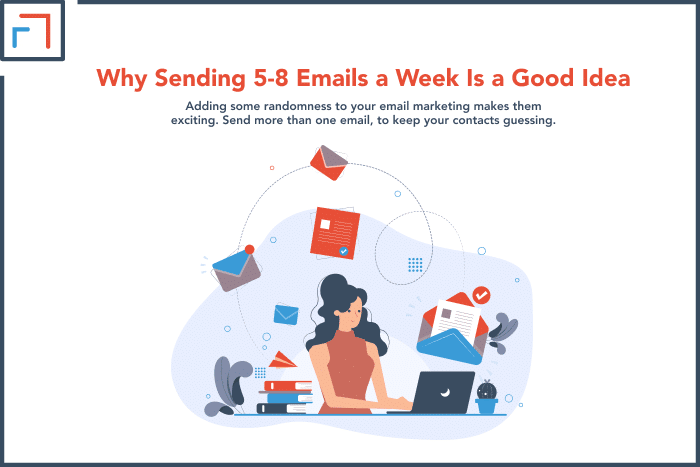There is a thin line between sending nagging emails and keeping your audience engaged. If you send too many emails, you risk annoying your contacts, leading to unsubscriptions. On the other hand, a few emails could mean missing out on conversions. Then, how do you find the balance?
The email frequency by industry ranges between 2 to 4 emails per month. However, industries like retail, e-Commerce stores, self-help, and fashion may send daily updates. On the other hand, government institutions and utility companies may require only a single email every month.
Before you increase or decrease your email frequency, let’s look at ideas you can use to determine the number of emails you should send per week or month.
How to Determine the Optimal Email Frequency for Your Business?
There is no one-size-fits-all magic number when it comes to email cadence. One company will thrive with a single email per month, while another will require daily updates.
Then, what factors affect how often you send emails to your audience?
1. What’s Your Industry?
One of the primary email cadence determinants is the industry you serve. For any industry, it is essential to understand customer expectations.
For example, if someone signs up for daily motivation, they are ready to receive your emails at least 5 days a week. On the other hand, professional service providers like lawyers should be moderate.
Some sectors, like tobacco processing, are restricted from sending marketing emails. In such cases, even a single email can cause penalties to violators.
Medical and pharmaceutical companies also have restrictive laws, and sending regular marketing emails is not prudent.
Industries with constant changes and updates, like news, fashion, and technology, require frequent emails to keep customers in the loop. Therefore, daily emails are ok if you serve such an audience.
The level of competition can also inform the number of emails you send to your contacts. For example, software companies send frequent emails to stay at the top of their targets’ minds.
2. Purchase Frequency
How often do customers buy your products after the first purchase? If you are in an industry with repeat orders from the same clients, you should send regular emails.
The emails should include discounts, exclusive offers, and vouchers for loyal customers. A good example is e-commerce stores that deal with consumable products.
Apart from offers, you can also include personalized recommendations of products or services.
In cases where you can easily predict a product’s lifecycle, like refill perfumes, you can align your emails with that.
Another example is the car service industry, where you can analyze a typical customer’s period to service their car.
Most industries tend to increase email frequency during seasonal promotions and holiday campaigns. This is understandable because even customers have that expectation.
So, you don’t have to worry about sending daily emails during the Black Friday season.
Although you can use purchase frequency to determine email cadence, avoid being intrusive. Customers can unsubscribe from your list if they feel like you are stalking them.

3. Customer Engagement
The level of engagement with your customers can help you determine how often you send emails. But how do you know how engaged or disengaged your audience is?
The most important engagement metrics are open rates, clicks, and conversions. If your contacts are opening the emails more, it means they are interested.
Therefore, you can increase the frequency to a level that gives optimal results.
Finding a balance between keeping customers engaged and avoiding email fatigue is a delicate balance. The best approach is to segment and automate your contact list with conditions.
For example, you can put subscribers that open more than 5 emails in a month in a different group from those that open less than 5 emails.
These segments may require different frequencies of engagement and content.
Providing your contact with preferences is even a better idea. Some customers prefer weekly emails, while others may opt for monthly communication.
In such a case, you are not using trial and error to identify what fits a certain segment.
4. Customer Journey
How long does a customer take to make the first purchase? How long do they take to become repeat buyers? Different industries have varying sales funnel cycles.
[P.S.: If the word sales funnel is unfamiliar to you, you can know all about it in my article on what are sales funnels and how do they work?]
If someone purchases a new vehicle today, the probability of buying another in less than two years is low. On the other hand, if a client takes a shave today, they might need another one in less than a month.
Understanding the dynamics of your customers can help you determine the most effective email frequency. This includes understanding the phase of their purchase journey.
Customers in the awareness stage need nurturing without disturbing them with daily emails. On the other hand, abandoned carts mean the customer may only need a little nudge, like a coupon, to check out.
Although the post-purchase stage may require fewer emails, it is good to keep the customers engaged. You can request referrals or create programs that encourage product or service advocacy.
In each customer journey stage, you should identify strategies to engage the contacts.

Optimal Email Frequency for Different Industries
After highlighting the factors determining the optimal email frequency, let’s see how often you should send emails in different industries.
| Industry | Monthly Email Frequency |
|---|---|
| Agriculture | 2 |
| Automobile | 2 |
| Business services | 4-5 |
| e-commerce | 8-10 |
| Computer and electronics | 3-4 |
| Construction | 2 |
| Education | 3-4 |
| Financial services | 4-5 |
| Food | 5-6 |
| Forestry | 2 |
| Government | 2 |
| Health services | 2 |
| Hotels & Tourism | 2-3 |
| Manufacturing | 3-4 |
| Media & news | 10-15 (sometimes even 20-30) |
| Mining | 2 |
| Non-profit organization | 2-3 |
| Self-help & Motivation | 8-15 |
| Shipping | 2 |
| Software | 3-4 |
| Textiles | 6-8 |
| Transport | 5-6 |
| Utilities | 3-4 |
Industries That Often Require Higher Email Frequencies
The media and entertainment industry has the highest email marketing frequency. This is understandable because you need daily news updates to inform you about what is happening.
If you are in the self-help and motivation industry, you may need to send more than one email weekly. Most people who sign-up on such platforms expect regular doses of encouraging messages.
Under this category are religious messages like devotionals.
Because of the competitive nature of the e-commerce industry, most companies tend to use aggressive email marketing.
When sending your emails, you should give vouchers, coupons, and exclusive discounts that benefit your contacts.
When it comes to fashion and apparel, the trends keep changing. So, it is common to receive regular updates on seasonal trends, limited-time promotions, and new collections.
Industries That Often Require Lower Email Frequencies
Some industries require less frequent and more formal communication. Some of them include accounting, legal, and consultancy.
In such emails, you should focus on providing high-value and personalized messages. Contacts in these industries may view frequent emails as spammy and intrusive.
The real estate industry involves significant decision-making that takes time. Communication in this industry focuses on property listing and important updates, which can be done once or twice a month.
If you need email marketing ideas for a real estate business, my article on Real Estate Email Marketing Tactics might prove to be a helpful read.
Non-governmental organizations also require fewer emails. The organizations focus on recruiting donors and maintaining the existing ones.
And where money is involved, emotions are fragile. Therefore, you should keep communication within 2 emails per month.
Why Sending 5-8 Emails a Week Is a Good Idea?
There are instances you may need to send 5-8 emails per month.
First, this increases your brand visibility and ensures you remain at the top of your customer’s minds. The approach is essential for highly competitive industries like e-commerce stores.
Also, sending frequent emails allows you to update your contacts. This tactic is good for the news and entertainment industries.
When your emails are interactive and the contacts are responding, you should keep the communication going. You can use this approach to inform customers about your products or services.

But No More than One a Day!
The email frequency between different industries varies a lot. While some, like news, require daily updates, others, such as accounting, have formalities that should be followed.
But still, if news websites can function with one email a day, there’s no reason for you to send more. My advice is to stay within the industry limits as depicted in the table above.
Plus, understanding your customers can help you know how often you can send emails.
Industry dynamics, purchase frequency, customer engagement, and lifecycle are some of the determinants of email cadence.
So, you should analyze these metrics for effective email strategies.
